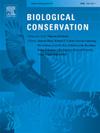Understanding unauthorised hunting for effective conservation interventions
IF 4.4
1区 环境科学与生态学
Q1 BIODIVERSITY CONSERVATION
引用次数: 0
Abstract
Interventions to deter unauthorised hunting tend to favour national parks over less strictly protected game reserves. A more effective approach, however, would be to base interventions on a better understanding of the underlying factors driving unauthorised hunting. Katavi National Park and Ugalla Game Reserve, Tanzania, sit within the same landscape. They both face the challenge of controlling unauthorised hunting, but differ in their protection status. Using focus group discussions, an indirect questioning technique, and household surveys, we determined levels of unauthorised wild meat hunting and consumption, the wildlife species preferred, and factors influencing participation in or deterrence from hunting. The findings suggest a wide range of wildlife species is used for wild meat, best estimates ranging from 17 % of households in villages along the main roads around Ugalla hunting for food over the last 12 months, to 47 % of households in trading centres around Katavi buying wild meat for consumption. Consumption was most common among people from larger households. The primary objective of hunting was to generate income, and the wild meat trade largely operated in local black markets. Factors leading to unauthorised hunting included a lack of conservation awareness, economic hardship, and limited alternative income sources. Conservation education, positive relationships between communities and protected areas, law enforcement, community engagement, and affordable game meat were commonly reported factors that could mitigate against unauthorised hunting. Our findings can inform more focussed and effective interventions to address unauthorised hunting by people living both close to and further away from protected areas.
了解非法狩猎,采取有效的保护措施
阻止非法狩猎的干预措施往往更倾向于国家公园,而不是保护不那么严格的狩猎保护区。然而,一个更有效的方法是在更好地了解导致非法狩猎的潜在因素的基础上进行干预。卡塔维国家公园和坦桑尼亚的乌加拉野生动物保护区坐落在同一风景中。它们都面临着控制非法狩猎的挑战,但它们的保护地位不同。通过焦点小组讨论、间接提问技术和家庭调查,我们确定了未经授权的野生肉类狩猎和消费水平、首选野生动物物种以及影响参与或阻止狩猎的因素。调查结果表明,各种野生动物物种被用于野生肉类,最准确的估计是,在过去的12个月里,乌加拉周围主要道路沿线村庄中有17%的家庭打猎取食,而卡塔维周围贸易中心47%的家庭购买野生肉类供消费。消费在大家庭中最为普遍。狩猎的主要目的是创收,野生肉类贸易主要在当地黑市进行。导致非法狩猎的因素包括缺乏保护意识、经济困难和有限的其他收入来源。保护教育、社区和保护区之间的积极关系、执法、社区参与和负担得起的野味是可以减轻非法狩猎的常见因素。我们的研究结果可以为更有针对性和更有效的干预措施提供信息,以解决生活在保护区附近和远离保护区的人们未经授权的狩猎问题。
本文章由计算机程序翻译,如有差异,请以英文原文为准。
求助全文
约1分钟内获得全文
求助全文
来源期刊

Biological Conservation
环境科学-环境科学
CiteScore
10.20
自引率
3.40%
发文量
295
审稿时长
61 days
期刊介绍:
Biological Conservation is an international leading journal in the discipline of conservation biology. The journal publishes articles spanning a diverse range of fields that contribute to the biological, sociological, and economic dimensions of conservation and natural resource management. The primary aim of Biological Conservation is the publication of high-quality papers that advance the science and practice of conservation, or which demonstrate the application of conservation principles for natural resource management and policy. Therefore it will be of interest to a broad international readership.
 求助内容:
求助内容: 应助结果提醒方式:
应助结果提醒方式:


